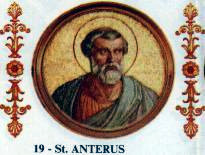January 3 (Eastern Orthodox liturgics)
Day in the Eastern Orthodox liturgical calendar From Wikipedia, the free encyclopedia
January 2 - Eastern Orthodox liturgical calendar - January 4

All fixed commemorations below are observed on January 16 by Eastern Orthodox Churches on the Old Calendar.[note 1]
For January 3rd, Orthodox Churches on the Old Calendar commemorate the Saints listed on December 21.
Feasts
- Forefeast of the Theophany of Our Lord and Savior Jesus Christ.[1][note 2]
Saints
- Holy Prophet Malachi (c. 400 BC)[1][3][4]
- Martyr Peter, in Avlona of Samaria, Palestine (311)[5]
- Martyr Gordius, at Caesarea in Cappadocia, centurion, by the sword (c. 314)[1][6][7][note 3]
- Venerable Meliton of Beirut (537)[9]
- Venerable Peter of Atroa (Peter the Standard-Bearer) (837)[1][10] (see also: September 13, January 1 - Western Rite)
- Venerable Acacius the Wonderworker, of Mount Latros (Latmos), at the Megisti Lavra of the Theotokos of Myrsinon (c. 10th century)[11][note 4]
- Saint Thomais of Lesbos (10th century)[1][12]
Pre-Schism Western saints
- Hieromartyr Daniel of Padua, a Deacon who helped St Prosdocimus, the first Bishop of Padua in Italy (168)[8][13]
- Saint Anterus, Pope of Rome (236)[13][note 5] ( see also August 5 - Eastern Calendar)
- Hieromartyr Florentius of Vienne, a martyred Bishop of Vienne in France (3rd century)[13][note 6]
- Venerable Genevieve of Paris (502)[1][8][13][14][15][16][17][note 7]
- Saint Fintan of Doon, a disciple of St Comgall at Bangor in Ireland; he is honoured as the patron-saint of Doon in Limerick where his holy well still exists (6th century)[13]
- Saint Finlugh of Derry (Finlag), a brother of St Fintan of Doon, he went to Scotland where he became one of St Columba's disciples; returning to Ireland, he became abbot of a monastery in County Londonderry (6th century)[13]
- Saint Blitmund, a monk at Bobbio Abbey in Italy (c. 660)[13][note 8]
- Saint Bertilia of Mareuil, anchoress (c. 687)[13][note 9]
- Saint Findlugan of Islay (Finlaggan, Fionn Lugain) (7th century)[1][note 10]
- Saint Wenog, an early saint in Wales.[13][note 11]
Post-Schism Orthodox saints
- Righteous Euthymius (Takaishvili) the Man of God, of Tbilisi (1953)[1][20][note 12]
Other commemorations
Icon gallery
- Saint Anterus, Pope of Rome.
- Venerable Genevieve of Paris.
- Righteous Ekvtime Takaishvili the Man of God, of Tbilisi.
Notes
- The notation Old Style or (OS) is sometimes used to indicate a date in the Julian Calendar (which is used by churches on the "Old Calendar").
The notation New Style or (NS), indicates a date in the Revised Julian calendar (which is used by churches on the "New Calendar"). - The second day of the Forefeast of Theophany falls on January 3. Today's hymns invite us to go in spirit to the Jordan River where the Creator comes to be baptized. He is the Light which shines in the darkness (John 1:5), and today He begins to overcome that darkness.[2]
- The many monks which had settled at Mt. Latros (Latmos) before the period of Emperor Leo VI the Wise (886-912 AD), eventually gave Mt. Latros (Latmos) the appellative "the Ephesian Mount Athos" ((in Greek): «τὸ κατ’ Ἔφεσον Ἅγιον Ὄρος»); this took place during the reign of Emperor Constantine Porphyrogenitus (913-959 AD).
- A Greek who was Pope of Rome for only a few weeks. He may have been martyred and was buried in the Catacomb of St Callistus, the first Pope to be so.
- Born in Nanterre near Paris in France, aged seven she became known to St Germanus of Auxerre. Aged fifteen, she became a nun. When Paris was occupied by the pagan Franks and afterwards threatened by Attila and the Huns, St Geneviève encouraged the people to defend the city. She has always been considered the special protectress and patroness of Paris, which she protected again in 1914.
- He followed St Walaricus (St Valéry) to France, where they founded the monastery of Leucone, later called Saint-Valéry. St Blitmund was the second abbot.
- "Eilean Mor (Finlaggan) appears in surviving documents as the Isle of St Finlagan (alternative spellings of the name being Findlugan or Fionn Lugain). A charter of 1427, for example, was witnessed as being granted "apud insula sancti Finlagani in Yle" (on the island of St Finlagan in Islay). Findlugan was a contemporary of St Columba (who was born in 521). St Columba established an Abbey in Tamlaght near Lough Foyle in 585 and installed Findlugan as its first Abbot. The monk made Scotland his missionary Field. Early monastic accounts tell how Findlugan saved the life of Columba when he interposed his body between the saint and a would-be assassin. This happened at Hinba, believed by some to have been Eileach an Naoimh, one of the Garvellochs, rocky islets north of Jura, or to have been Jura itself. It is possible Findlugan established an early monastic community on the island bearing his name. The Chapel built much later was certainly dedicated to him. Over the years the spelling changed -the loch became known as Finlaggan and the island as Eilean Mor."[18]
- The Holy Synod of the Georgian Apostolic Orthodox Church canonized St. Ekvtime on October 17, 2002, and joyously proclaimed him a “Man of God.”
References
Sources
Wikiwand - on
Seamless Wikipedia browsing. On steroids.



